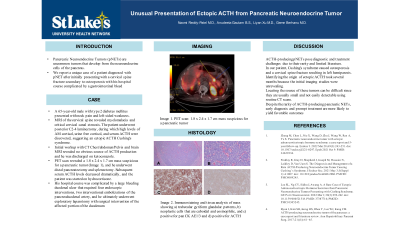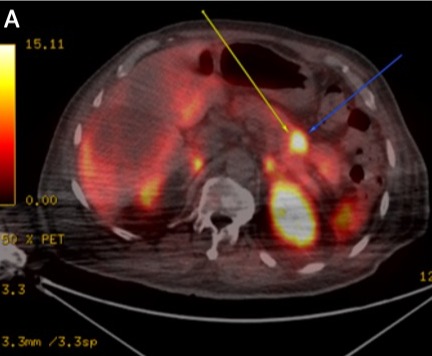Tuesday Poster Session
Category: Biliary/Pancreas
P2971 - Unusual Presentation of Ectopic ACTH from Pancreatic Neuroendocrine Tumor
Tuesday, October 24, 2023
10:30 AM - 4:00 PM PT
Location: Exhibit Hall

Has Audio

Naomi Reddy-Patel, MD
St. Luke's University Hospital
Bethlehem, PA
Presenting Author(s)
Naomi Reddy-Patel, MD1, Anudeeta Gautam, BS1, Ammar Alam, DO1, Zarian Prenatt, DO2, Het Patel, DO2, Berhanu Geme, MD1
1St. Luke's University Hospital, Bethlehem, PA; 2St. Luke's University Health Network, Bethlehem, PA
Introduction: Pancreatic Neuroendocrine Tumors (pNETs) are uncommon tumors that develop from the neuroendocrine cells of the pancreas. They represent a small portion of all pancreatic cancers and can secrete various hormones, such as insulin or gastrin. A small subset of pNETs can produce adrenocorticotropic hormone (ACTH), making it particularly difficult to detect due to varying patient presentations. We report a unique case of a patient diagnosed with pNET after initially presenting with a cervical spine fracture secondary to osteoporosis with his hospital course complicated by a gastrointestinal bleed.
Case Description/Methods: A 65-year-old male with type 2 diabetes mellitus presented with neck pain and left-sided weakness. A head CT was negative, however an MRI of the cervical spine revealed myelomalacia and critical cervical canal stenosis. The patient underwent posterior C2-4 laminectomy, during which high levels of AM cortisol, urine free cortisol, and serum ACTH were discovered, suggesting an ectopic ACTH Cushing's syndrome. Initial workup with CT Chest/abdomen/Pelvis and brain MRI revealed no obvious source of ACTH production and he was discharged on ketoconazole. The patient was then readmitted with fever secondary to ESBL bacteremia for which he was treated with ertapenem. A PET scan revealed a 1.8 x 2.4 x 1.7 cm mass suspicious for a pancreatic tumor (Image A), and he underwent distal pancreatectomy and splenectomy. Subsequent serum ACTH levels decreased dramatically, and the patient was started on hydrocortisone. His hospital course was complicated by a large bleeding duodenal ulcer that required four endoscopic interventions, two interventional embolizations of the pancreoduodenal artery, and he ultimatly underwent exploratory laparotomy with surgical intervention of the affected portion of the duodenum.
Discussion: ACTH-producing pNETs pose diagnostic and treatment challenges due to their rarity and limited literature. Clinical manifestations vary from weight gain to severe fatigue. In our patient, Cushing's syndrome caused osteoporosis and a cervical spine fracture resulting in left hemiparesis. Identifying the origin of ectopic ACTH took several months because the initial imaging studies were unrevealing. Locating the source of these tumors can be difficult since they are usually small and not easily detectable using routine CT scans. Despite the rarity of ACTH-producing pancreatic NETs, early diagnosis and prompt treatment are more likely to yield favorable outcomes.

Disclosures:
Naomi Reddy-Patel, MD1, Anudeeta Gautam, BS1, Ammar Alam, DO1, Zarian Prenatt, DO2, Het Patel, DO2, Berhanu Geme, MD1. P2971 - Unusual Presentation of Ectopic ACTH from Pancreatic Neuroendocrine Tumor, ACG 2023 Annual Scientific Meeting Abstracts. Vancouver, BC, Canada: American College of Gastroenterology.
1St. Luke's University Hospital, Bethlehem, PA; 2St. Luke's University Health Network, Bethlehem, PA
Introduction: Pancreatic Neuroendocrine Tumors (pNETs) are uncommon tumors that develop from the neuroendocrine cells of the pancreas. They represent a small portion of all pancreatic cancers and can secrete various hormones, such as insulin or gastrin. A small subset of pNETs can produce adrenocorticotropic hormone (ACTH), making it particularly difficult to detect due to varying patient presentations. We report a unique case of a patient diagnosed with pNET after initially presenting with a cervical spine fracture secondary to osteoporosis with his hospital course complicated by a gastrointestinal bleed.
Case Description/Methods: A 65-year-old male with type 2 diabetes mellitus presented with neck pain and left-sided weakness. A head CT was negative, however an MRI of the cervical spine revealed myelomalacia and critical cervical canal stenosis. The patient underwent posterior C2-4 laminectomy, during which high levels of AM cortisol, urine free cortisol, and serum ACTH were discovered, suggesting an ectopic ACTH Cushing's syndrome. Initial workup with CT Chest/abdomen/Pelvis and brain MRI revealed no obvious source of ACTH production and he was discharged on ketoconazole. The patient was then readmitted with fever secondary to ESBL bacteremia for which he was treated with ertapenem. A PET scan revealed a 1.8 x 2.4 x 1.7 cm mass suspicious for a pancreatic tumor (Image A), and he underwent distal pancreatectomy and splenectomy. Subsequent serum ACTH levels decreased dramatically, and the patient was started on hydrocortisone. His hospital course was complicated by a large bleeding duodenal ulcer that required four endoscopic interventions, two interventional embolizations of the pancreoduodenal artery, and he ultimatly underwent exploratory laparotomy with surgical intervention of the affected portion of the duodenum.
Discussion: ACTH-producing pNETs pose diagnostic and treatment challenges due to their rarity and limited literature. Clinical manifestations vary from weight gain to severe fatigue. In our patient, Cushing's syndrome caused osteoporosis and a cervical spine fracture resulting in left hemiparesis. Identifying the origin of ectopic ACTH took several months because the initial imaging studies were unrevealing. Locating the source of these tumors can be difficult since they are usually small and not easily detectable using routine CT scans. Despite the rarity of ACTH-producing pancreatic NETs, early diagnosis and prompt treatment are more likely to yield favorable outcomes.

Figure: (Image A) PET/CT Ga dotatate scan with 1.8x2.4x1.7cm mass in the pancreas
Disclosures:
Naomi Reddy-Patel indicated no relevant financial relationships.
Anudeeta Gautam indicated no relevant financial relationships.
Ammar Alam indicated no relevant financial relationships.
Zarian Prenatt indicated no relevant financial relationships.
Het Patel indicated no relevant financial relationships.
Berhanu Geme indicated no relevant financial relationships.
Naomi Reddy-Patel, MD1, Anudeeta Gautam, BS1, Ammar Alam, DO1, Zarian Prenatt, DO2, Het Patel, DO2, Berhanu Geme, MD1. P2971 - Unusual Presentation of Ectopic ACTH from Pancreatic Neuroendocrine Tumor, ACG 2023 Annual Scientific Meeting Abstracts. Vancouver, BC, Canada: American College of Gastroenterology.
